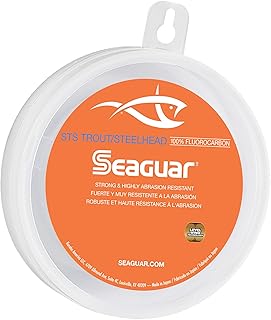5 important factors worth considering when looking for the best fluorocarbon line for trout
Choosing the right fluorocarbon line is important for trout fishing success. Things like line thickness, knot strength, how well it can’t be seen in water, and how sensitive it is all matter a lot. Understanding these factors can help you improve your trout fishing skills.
See our guide to the best fluorocarbon line for trout.
Diameter
When choosing a fluorocarbon line for trout fishing, it’s important to consider the diameter of the line. Some people think that thinner line is always better, but that’s not always true. While thinner line may be more sensitive and less visible, it can also be weaker and more prone to getting damaged.
In my experience, using a slightly thicker fluorocarbon line can be better when fishing for trout. Thicker line is less likely to break when a trout is fighting, especially in rocky or brushy areas. It also tends to be stronger when tying knots, reducing the risk of the line breaking when you really need it.
Ultimately, picking the right diameter fluorocarbon line for trout fishing means thinking about the conditions where you’ll be fishing and finding a balance between performance and reliability.
Strength
Strength is an important factor to think about when buying fluorocarbon line for trout fishing. Choosing a line with the right strength is key to having successful fishing trips. Some people think that heavier lines are always stronger, but this is not true. Light fluorocarbon lines can be strong and sensitive, giving anglers the best of both worlds. By picking a fluorocarbon line that balances strength and sensitivity, anglers can improve their chances of catching trout without sacrificing performance.
The strength of a fluorocarbon line is also important for handling big trout that fight hard. A strong line can handle the force and tension from trout during the fight, reducing the chance of breaking and leading to a successful catch. Investing in a good-quality fluorocarbon line with enough strength not only makes fishing more enjoyable, but also gives anglers confidence when faced with tough fishing situations. Ultimately, when buying fluorocarbon line for trout fishing, focusing on strength is a smart choice that can greatly impact your fishing success.
Visibility
When shopping for fluorocarbon line for trout fishing, it’s important to consider visibility. Fluorocarbon is hard to see in the water, which can be a big advantage when fishing for cautious trout in clear streams or lakes. Even though some anglers think visibility doesn’t matter as much in deeper water or with heavier gear, trout have sharp eyes and notice any unusual things around them. Choosing a low-visibility fluorocarbon line can help your presentation look natural, making it more likely to attract even wary trout.
Modern fluorocarbon lines are designed to be almost invisible underwater, thanks to improved technology. Investing in a high-quality, low-visibility fluorocarbon line can make your fishing more successful by helping you be stealthier. While these lines may cost a bit more than traditional monofilament lines, the benefits of using low-visibility fluorocarbon outweigh the extra expense, especially in clear water. Prioritizing visibility when picking fluorocarbon line for trout isn’t just a personal preference – it’s a smart choice that can improve your fishing trips.
Abrasion resistance
Choosing fluorocarbon line for trout fishing requires considering abrasion resistance. Trout can be elusive and thrive in rugged environments, often rubbing against rocks and debris. Opting for fluorocarbon line with high abrasion resistance can prevent it from snapping due to friction or sharp edges when reeling in a prized trout.
Investing in fluorocarbon line with superior abrasion resistance not only prolongs the life of your gear but also increases your chances of success. Trout fishing demands finesse and precision, and a durable line can withstand angling in rough terrain, giving you an advantage. Prioritizing abrasion resistance in your fluorocarbon line selection allows you to fish confidently, knowing it can handle challenges in trout-filled waters.
Stretchability
When choosing a fluorocarbon line for trout fishing, people often focus on things like how well the fish can see it and how durable it is. But it’s important to also think about how much the line can stretch. Having a line with low stretch can make a big difference when you’re out fishing. It allows you to feel even the smallest nibbles and react quickly, leading to more fish caught and fewer missed chances.
Not only does a low-stretch fluorocarbon line improve your ability to set the hook, but it also gives you a direct connection to your bait. This direct line of communication helps you present your bait more accurately and control your casts better, giving you a better chance of catching a big trout. So, when you’re looking for a fluorocarbon line, think about how much it stretches in addition to other features. It can help take your trout fishing to the next level.
Conclusion
When it comes to trout fishing, using fluorocarbon line is a game-changer. It makes it easier to feel when a fish bites and helps you sneak up on them without being seen. The line is strong and hard to see underwater, making it perfect for fishermen who want to be accurate and successful. Choosing to use fluorocarbon line shows that you’re open to new ideas and dedicated to improving your fishing trips. It’s a must-have for anyone trying to catch tricky trout. Want more info on pool noodles, check the best pool noodles.
